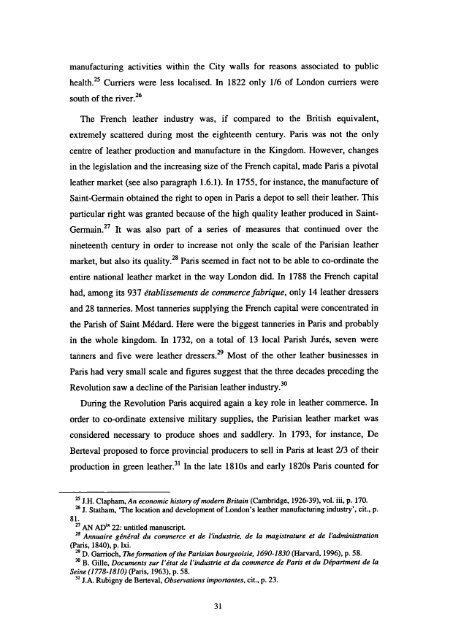The Boot and Shoe Trades in London and Paris in the Long Eighteenth Century
The Boot and Shoe Trades in London and Paris in the Long Eighteenth Century
The Boot and Shoe Trades in London and Paris in the Long Eighteenth Century
You also want an ePaper? Increase the reach of your titles
YUMPU automatically turns print PDFs into web optimized ePapers that Google loves.
manufactur<strong>in</strong>g activities with<strong>in</strong> <strong>the</strong> City walls for reasons associated to public<br />
health. 25 Curriers were less localised. In 1822 only 1/6 of <strong>London</strong> curriers were<br />
south of <strong>the</strong> river.26<br />
<strong>The</strong> French lea<strong>the</strong>r <strong>in</strong>dustry was, if compared to <strong>the</strong> British equivalent,<br />
extremely scattered dur<strong>in</strong>g most <strong>the</strong> eighteenth century. <strong>Paris</strong> was not <strong>the</strong> only<br />
centre of lea<strong>the</strong>r production <strong>and</strong> manufacture <strong>in</strong> <strong>the</strong> K<strong>in</strong>gdom. However, changes<br />
<strong>in</strong> <strong>the</strong> legislation <strong>and</strong> <strong>the</strong> <strong>in</strong>creas<strong>in</strong>g size of <strong>the</strong> French capital, made <strong>Paris</strong> a pivotal<br />
lea<strong>the</strong>r market (see also paragraph 1.6.1). In 1755, for <strong>in</strong>stance, <strong>the</strong> manufacture of<br />
Sa<strong>in</strong>t-Germa<strong>in</strong> obta<strong>in</strong>ed <strong>the</strong> right to open <strong>in</strong> <strong>Paris</strong> a depot to sell <strong>the</strong>ir lea<strong>the</strong>r. This<br />
particular right was granted because of <strong>the</strong> high quality lea<strong>the</strong>r produced <strong>in</strong> Sa<strong>in</strong>t-<br />
Germa<strong>in</strong>. 27 It was also part of a series of measures that cont<strong>in</strong>ued over <strong>the</strong><br />
n<strong>in</strong>eteenth century <strong>in</strong> order to <strong>in</strong>crease not only <strong>the</strong> scale of <strong>the</strong> <strong>Paris</strong>ian lea<strong>the</strong>r<br />
market, but also its quality. 28 <strong>Paris</strong> seemed <strong>in</strong> fact not to be able to co-ord<strong>in</strong>ate <strong>the</strong><br />
entire national lea<strong>the</strong>r market <strong>in</strong> <strong>the</strong> way <strong>London</strong> did. In 1788 <strong>the</strong> French capital<br />
had, among its 937 établissements de commerce fabrique, only 14 lea<strong>the</strong>r dressers<br />
<strong>and</strong> 28 tanneries. Most tanneries supply<strong>in</strong>g <strong>the</strong> French capital were concentrated <strong>in</strong><br />
<strong>the</strong> <strong>Paris</strong>h of Sa<strong>in</strong>t Médard. Here were <strong>the</strong> biggest tanneries <strong>in</strong> <strong>Paris</strong> <strong>and</strong> probably<br />
<strong>in</strong> <strong>the</strong> whole k<strong>in</strong>gdom. In 1732, on a total of 13 local <strong>Paris</strong>h Jurés, seven were<br />
tanners <strong>and</strong> five were lea<strong>the</strong>r dressers. 29 Most of <strong>the</strong> o<strong>the</strong>r lea<strong>the</strong>r bus<strong>in</strong>esses <strong>in</strong><br />
<strong>Paris</strong> had very small scale <strong>and</strong> figures suggest that <strong>the</strong> three decades preced<strong>in</strong>g <strong>the</strong><br />
Revolution saw a decl<strong>in</strong>e of <strong>the</strong> <strong>Paris</strong>ian lea<strong>the</strong>r <strong>in</strong>dustry.30<br />
Dur<strong>in</strong>g <strong>the</strong> Revolution <strong>Paris</strong> acquired aga<strong>in</strong> a key role <strong>in</strong> lea<strong>the</strong>r commerce. In<br />
order to co-ord<strong>in</strong>ate extensive military supplies, <strong>the</strong> <strong>Paris</strong>ian lea<strong>the</strong>r market was<br />
considered necessary to produce shoes <strong>and</strong> saddlery. In 1793, for <strong>in</strong>stance, De<br />
Berteval proposed to force prov<strong>in</strong>cial producers to sell <strong>in</strong> <strong>Paris</strong> at least 2/3 of <strong>the</strong>ir<br />
production <strong>in</strong> green lea<strong>the</strong>r. 3' In <strong>the</strong> late 1810s <strong>and</strong> early 1820s <strong>Paris</strong> counted for<br />
J.H. Clapham, An economic history of modern Brita<strong>in</strong> (Cambridge, 1926-39), vol. iii, p. 170.<br />
J. Statham, '<strong>The</strong> location <strong>and</strong> development of <strong>London</strong>'s lea<strong>the</strong>r manufactur<strong>in</strong>g <strong>in</strong>dustry', cit., p.<br />
81.<br />
v AN ADIX 22: untitled manuscript.<br />
28<br />
Annuaire general du commerce et de l'<strong>in</strong>dustrie, de la magistrature et de ladm<strong>in</strong>istration<br />
(<strong>Paris</strong>, 1840), p. lxi.<br />
29 D Garrioch, <strong>The</strong> formation of <strong>the</strong> <strong>Paris</strong>ian bourgeoisie, 1690-1 830 (Harvard, 1996), p. 58.<br />
°<br />
B. Gille, Documents sur l'état de l'<strong>in</strong>dustrie et du commerce de <strong>Paris</strong> et du Department de Ia<br />
Se<strong>in</strong>e (1778-1810) (<strong>Paris</strong>, 1963), p. 58.<br />
J.A. Rubigny de Berteval, Observations importantes, cit., p. 23.<br />
31


